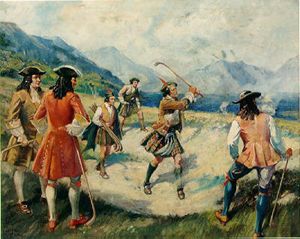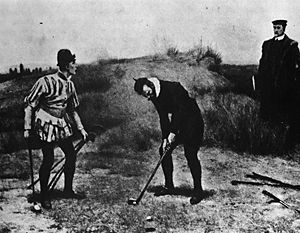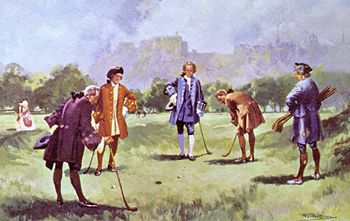In The
Beginning:
 |
Most historians concede
it was the Scots who introduced "golfe" to the
world and no authenticated records exist to contradict
this. Although the actual origins of golf are unknown,
there is evidence St. Andrews, Scotland is indeed the
cradle of the world's most popular game. |
The game of golf is at least 600 years
old. There is plenty of evidence that golf was played at
St. Andrews in Scotland before the founding of the University
there in 1411, and there is sufficient indications to make
a safe assumption that it was being played there in one
form or another for a century before that.
There have been claims to
the game's origins by the French and the Dutch, but their
cases are flawed. The Dutch cite the club and ball game
of "Kolven"; the French point to a game called
"Jeu de mail". Those games don't quite cut it
since they lack one important element - the hole.
Golf is alone in games in that the object of the game is
to propel a ball across a course liberally littered with
obstacles designed to prevent you from doing so, and into
a hole. The hole is the vital factor in separating golf
from other club and ball games.
Some say that golf was first played by shepherds tending
their flocks, passing the time by hitting rocks to targets
with their staffs. Games would have developed between competing
shepherds, playing across the grazing lands links and back
to their village.
In any event, it was only a matter of time before a pebble
would roll into a sandy hollow formed when sheep had overgrazed
the land while huddling for shelter against the icy winds
along the shores. The unfortunate golfer would have found
himself playing from the worlds first bunker.
If only someone had documented the events of its earliest
beginnings.

The Sabath Breakers - 16th
Century |
In 1457, King James II of Scotland
felt that golf was interfering with archery practice.
He banned the game by a Scottish Act of Parliament of
that year - the first documented reference to today's
game. The Scots ignored the ban and the nation's growing
ability to play golf had been in equal proportion to
the decline in its ability as archers. In battle, the
ability to hit the |
bump and run was no substitute for
an effective bow and arrow. In many parts of Scotland's
East Coast, parishioners were constantly being punished
for playing golf "at the time of the preaching of the
Sermon".
James IV also tried to stop
the Scots playing golf, but eventually he took up the game
himself. By 1501 his treasurer had paid 14 shilling to a
bow maker in Perth to supply clubs. From then onwards there
was a series of bills paid from the royal coffers for golf
clubs and balls, and even for the king's lost bets.
Interest in golf later expanded to England, where under
the influence of political powers, land grants for links
and other facilities were provided. Membership to these
clubs and golfing societies carried a considerable amount
of prestige. "Gentleman Golfers" were considered
privileged groups indulging in a "legal, honorable,
and respectful sport."
It was during the 16th century that it became firmly established
on the East Coast of Scotland and began to spread. By this
time the game had gained respectability among high society
and was even played by Mary Queen of Scots. She played golf
with one of her attendants, Mary Seton, and in fact, the
queen lost a match to her and presented her with a famous
necklace. Mary Queen of Scots found herself in hot water
for playing golf at Seton House shortly after the murder
of her husband, Lord Darnley, in 1567. Many thought her
enjoyment of the sport during the mourning period was unacceptable.
Ironically, after so much resistance, it was the royal acceptance
of the game that helped spread it throughout the country
and beyond. Despite its popularity, it was another 150 years
before efforts were made to bring any organization to the
game of golf.
In 1659, golf was banned from the streets of Albany, New
York. This is the first known reference to golf in America.
In 1687, a book by Thomas Kincaid, "Thoughts on Golve,"
contains the first instructions on how to make golf clubs.

Bruntsfield Links 1750 |
The first formal golf club, the
Company of Gentlemen Golfers (now the Honourable Company
of Edinburgh Golfers) was established in Edinburgh,
in 1744 at Leith Links. They oversaw the |
introduction of the first
set of rules. The United States Golf Association and the
Royal and Ancient Golf Club of St. Andrews currently govern
the rules of golf. The "R&A" is the most widely
accepted governing body throughout the world. The European
tour is subject to the R&A. The USGA governs play in
the United States.
In 1857, The Golfer's Manual,
by "A Keen Hand" (H.B. Farnie), was published.
It was the first book on golf instruction.
In 1861, The Professionals Championship was opened to amateurs,
and the British Open was born. Old Tom Morris won the first
tournament.
| The first permanent golf club
in North America, Canada's Royal Montreal Club, host
to the 1997 Canadian Open Championship, was founded
in 1873. St. Andrews, one of the oldest golf clubs in
the United States, was established as a 3-hole |

Apple Tree Gang 1888 |
layout in 1888 at Yonkers,
N.Y. Its founders were known as the "Apple Tree Gang"
because of the many apple trees on their course. It was
extended to 6 holes on a cow pasture. During the next few
years numerous 6-, 8-, 9-, and 12-hole courses were opened
in the East. The first 18-hole course in the United States,
the Chicago Golf Club, was founded near Wheaton, Ill., in
1893.
The latter part of the 19th
century saw the major development of the game in Scotland,
with the construction of many new courses. The arrival of
the gutta percha ball, around 1880, was the single major
factor in the explosion of the popularity of the game.
In 1890, there were 387 golf courses worldwide. By 1895,
the number had grown to 1280. It took 500 years to build
the first 400 courses, and just 5 more years to triple that
number. In the scheme of things, that explosion could be
considered nuclear. During that period, earthmoving was
a monumental task, and horsepower meant horses.
There were 80 courses in the U.S. in 1896. By 1930 almost
6,000 courses had been built. The next two decades saw golf
course construction come to a complete standstill. Between
the stock market crash and WWII, golf courses did not have
a chance. The 50's saw many golf courses destroyed to make
way for highways and housing developments. In 1955, 600
courses were lost forever and only 200 new courses opened.
1890 also saw Hugh Rotherham's invention of the hypothetical
score of an expert golfer who plays perfect golf on every
hole. He called it a "Ground Score". Dr. Thomas
Brown, honourary Secretary of the Great Yarmouth Club, christened
this perfect golfer the "Bogey Man," after a hit
song of the day, and declared his score a "Bogey."
Since the improvements in length achieved by better balls
and equipment, the holes got "shorter" and the
perfect score was called Par and a Bogey became one over
par.
|







